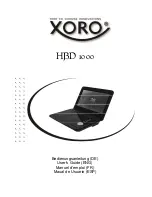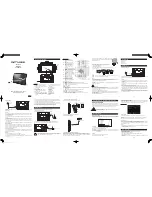
5
ENGINE SAFETY
Internal combustion engines present special hazards during operation and fueling! Failure to follow the
safety guidelines described below could result in severe injury or death. Read and follow all safety warnings
described in the engine operator's manual. A copy of this manual was supplied with the unit when it was
shipped from the factory.
•
DO NOT
run engine indoors or in an area with poor ventilation unless exhaust hoses are used. Gasoline
exhaust contains carbon monoxide, a deadly, odorless and colorless gas which, if inhaled, can cause
nausea, fainting or death. Make sure engine exhaust cannot seep into closed rooms or ventilation
equipment.
•
DO NOT
fill fuel tank near an open flame, while smoking, or while engine is running.
DO NOT
fill tank
in an enclosed area with poor ventilation.
•
DO NOT
operate with the fuel tank cap loose or missing.
•
DO NOT
touch or lean against hot exhaust pipes or engine cylinders.
•
DO NOT
clean air filter with gasoline or other types of low flash point solvents.
•
DO NOT
remove engine coolant cap while engine is hot.
•
DO NOT operate the unit without a functional exhaust system.
Prolonged exposure to sound
levels in excess of 85 DBA can cause permanent hearing loss. Wear hearing protection when working
around a running engine.
•
Keep hands, feet and loose clothing away from moving parts on the generator and engine.
•
Keep area around exhaust pipes and air ducts free of debris to reduce the chance of an accidental fire.
•
Batteries contain sulfuric acid which can cause severe injury or death. Sulfuric acid can cause eye
damage, burn flesh or eat holes in clothing. Protective eye wear and clothing are necessary when
working on or around the battery. Always disconnect the NEGATIVE (-) battery cable from the
corresponding terminal before performing any service on the engine or other components.
ELECTRICAL SAFETY
The unit is powered by a generator driven by a gasoline powered engine. While the engine is running,
potentially lethal voltages are present at the 120V Ground Fault Circuit Interrupt (GFCI) outlets and the
240V twist lock outlets located on the control panel, and at the connection lugs and cam lock receptacles.
Failure to follow the safety guidelines described below could result in severe injury or death.
•
Only a qualified and licensed electrician should make connections to the generator.
•
NEVER
wash the unit with any high pressure hoses or power washers.
•
NEVER
start the unit under load. The circuit breakers must be in the “OFF” position when starting the
unit in MANUAL mode. The circuit breakers can be in the “ON” position only when started in the AUTO
mode. A transfer switch must be used in the AUTO mode to deflect the load upon start up.
•
ALWAYS
disconnect the NEGATIVE (-) battery cable from the corresponding terminal before perform-
ing any service on the engine, generator or any other components. Remove the NEGATIVE (-) battery
cable from the corresponding terminal if the unit is to be stored or transported.
•
ALWAYS
use extreme caution when servicing this unit in damp conditions. Do not service the unit if
your skin or clothing is wet. Do not allow water to collect around the base of the unit.
•
ALWAYS
connect the unit to a good earthen ground before use. Follow any local, state or United
States National Electric Code (NEC) guidelines.






































